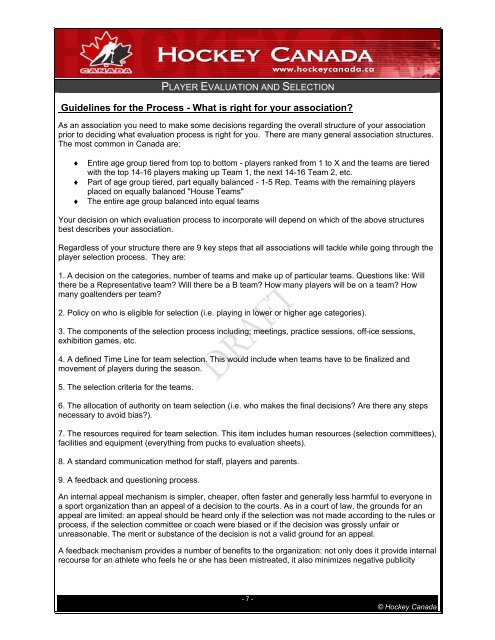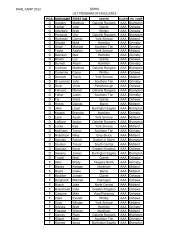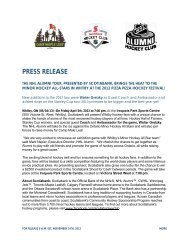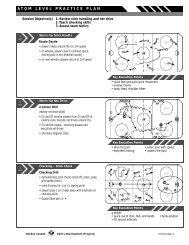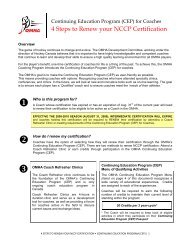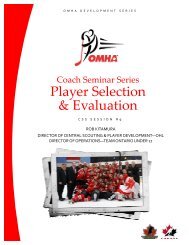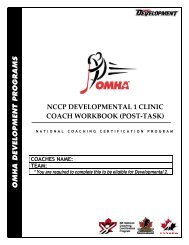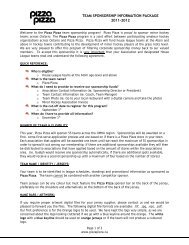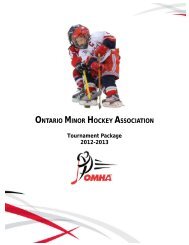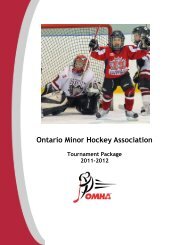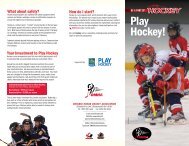Player Evaluation & Selection - Ontario Minor Hockey Association
Player Evaluation & Selection - Ontario Minor Hockey Association
Player Evaluation & Selection - Ontario Minor Hockey Association
You also want an ePaper? Increase the reach of your titles
YUMPU automatically turns print PDFs into web optimized ePapers that Google loves.
PLAYER EVALUATION AND SELECTION<br />
Guidelines for the Process - What is right for your association?<br />
As an association you need to make some decisions regarding the overall structure of your association<br />
prior to deciding what evaluation process is right for you. There are many general association structures.<br />
The most common in Canada are:<br />
♦ Entire age group tiered from top to bottom - players ranked from 1 to X and the teams are tiered<br />
with the top 14-16 players making up Team 1, the next 14-16 Team 2, etc.<br />
♦ Part of age group tiered, part equally balanced - 1-5 Rep. Teams with the remaining players<br />
placed on equally balanced "House Teams"<br />
♦ The entire age group balanced into equal teams<br />
Your decision on which evaluation process to incorporate will depend on which of the above structures<br />
best describes your association.<br />
Regardless of your structure there are 9 key steps that all associations will tackle while going through the<br />
player selection process. They are:<br />
1. A decision on the categories, number of teams and make up of particular teams. Questions like: Will<br />
there be a Representative team? Will there be a B team? How many players will be on a team? How<br />
many goaltenders per team?<br />
2. Policy on who is eligible for selection (i.e. playing in lower or higher age categories).<br />
3. The components of the selection process including; meetings, practice sessions, off-ice sessions,<br />
exhibition games, etc.<br />
4. A defined Time Line for team selection. This would include when teams have to be finalized and<br />
movement of players during the season.<br />
5. The selection criteria for the teams.<br />
6. The allocation of authority on team selection (i.e. who makes the final decisions? Are there any steps<br />
necessary to avoid bias?).<br />
7. The resources required for team selection. This item includes human resources (selection committees),<br />
facilities and equipment (everything from pucks to evaluation sheets).<br />
8. A standard communication method for staff, players and parents.<br />
9. A feedback and questioning process.<br />
An internal appeal mechanism is simpler, cheaper, often faster and generally less harmful to everyone in<br />
a sport organization than an appeal of a decision to the courts. As in a court of law, the grounds for an<br />
appeal are limited: an appeal should be heard only if the selection was not made according to the rules or<br />
process, if the selection committee or coach were biased or if the decision was grossly unfair or<br />
unreasonable. The merit or substance of the decision is not a valid ground for an appeal.<br />
A feedback mechanism provides a number of benefits to the organization: not only does it provide internal<br />
recourse for an athlete who feels he or she has been mistreated, it also minimizes negative publicity<br />
- 7 -<br />
© <strong>Hockey</strong> Canada


